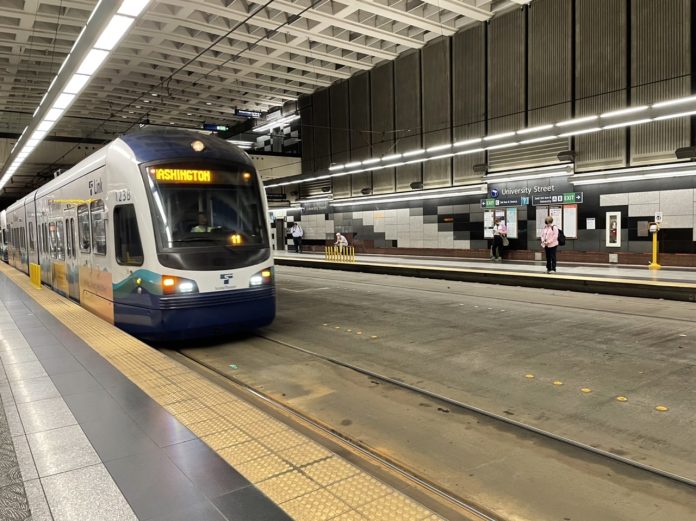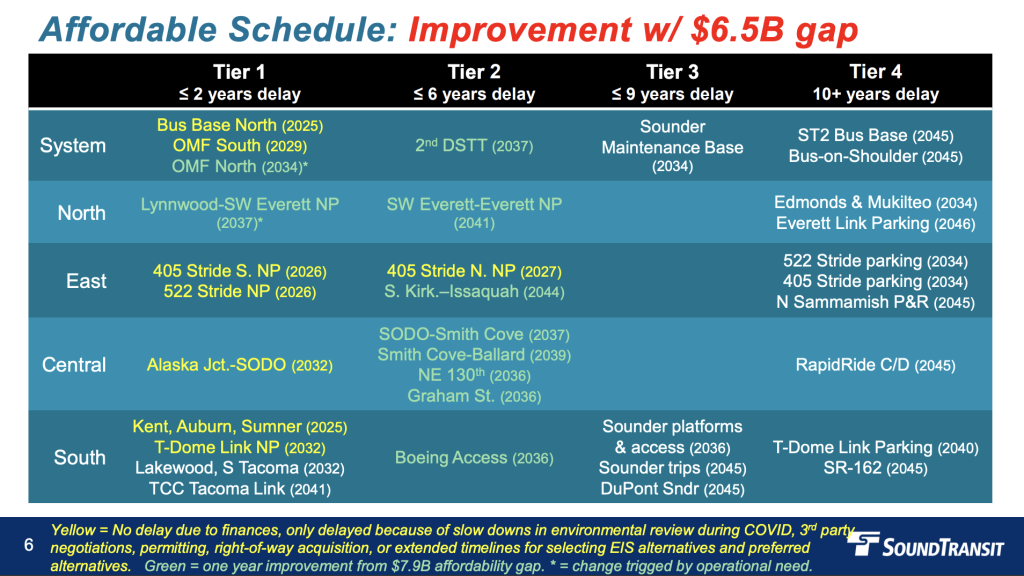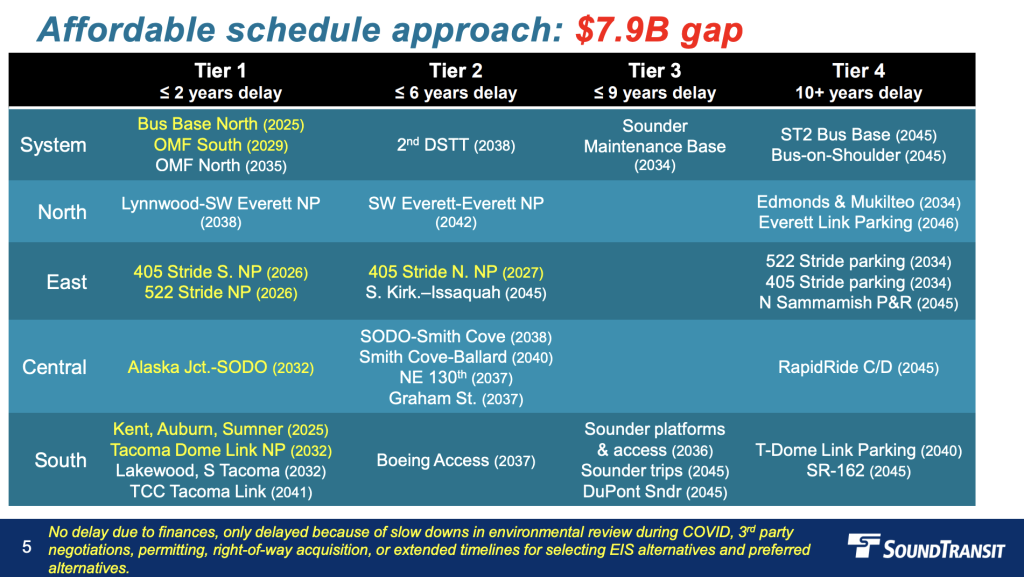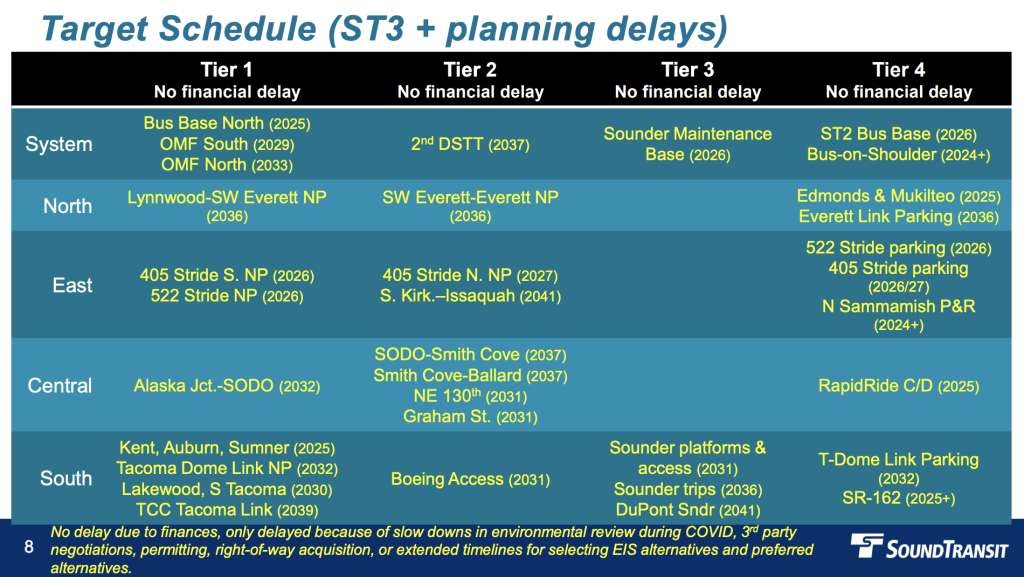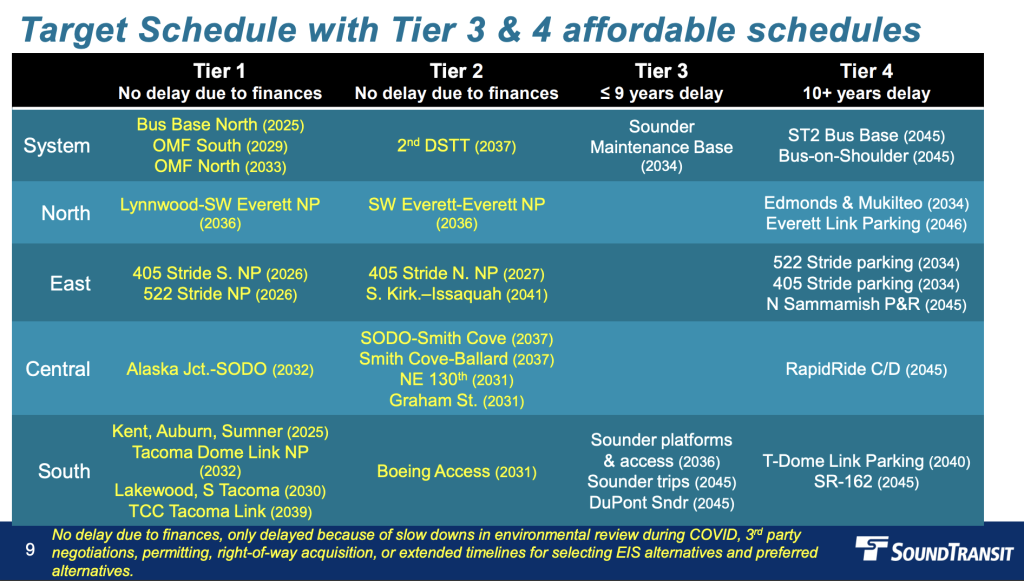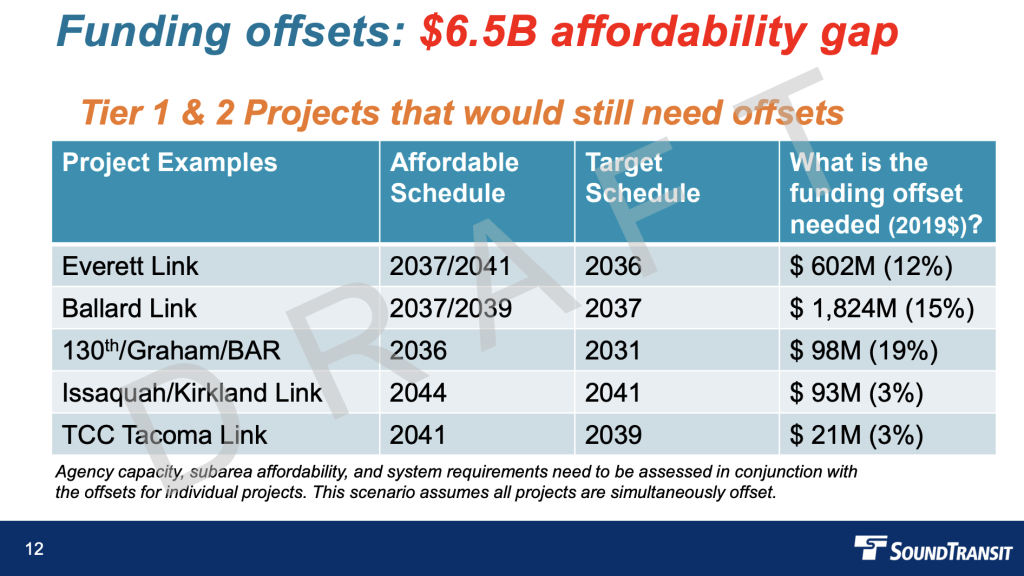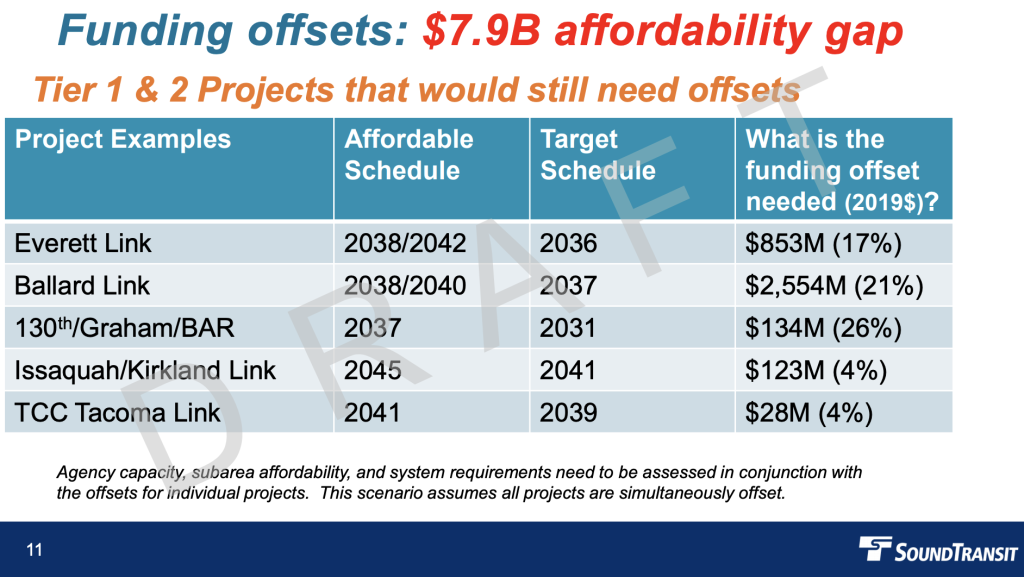A hybrid approach that could partially or fully salvage Sound Transit 3 (ST3) project delivery timelines may become the preferred realignment plan. On Thursday, King County Councilmember Claudia Balducci unveiled the plan with Kent Keel, Chair of the Sound Transit Board of Directors, at the monthly board meeting. The hybrid approach is described as a “tightrope with a safety net” that could keep many projects on their voter-approved timelines, except where “planning delays” and other factors might still require pushing delivery dates backward. New amendments proposed by boardmembers were also released ahead of the meeting, which would mostly be better for riders — though one amendment would decidedly hurt them.
Where the plan could be headed
The realignment process could wrap up on Thursday, August 5th when the next meeting on the effort is scheduled. It’s possible that Keel’s base realignment plan — which immediately establishes delays for projects ranging from a few years to decades — could be picked if boardmembers decided to do so, but Keel and Balducci seemed to have reached agreement on the hybrid approach. Either realignment plan approach could solve Sound Transit’s $6.5 billion affordability gap, which shrank this month from the previous $7.9 billion estimate in April. Further reductions to the affordability gap could come in the months and years ahead as project savings and additional revenues are identified.
“I believe this hybrid combines the best of my approach and the best of [Balducci’s] approach that she’s been working,” Keel said at the meeting. “So the three things that lead me to that includes the agency’s clear expectation that we will work aggressively to deliver on most every project on-time. It also includes [Balducci’s] process through which we will work to close each project’s affordability gap so that we can deliver them on-time.” Continuing, Keel said: “And like I’ve been saying all along, it also makes clear to the public what financial constraints that we have right now before us and when we can realistically deliver the projects if we cannot close the affordability gap.”
Balducci also weighed in on the hybrid realignment plan that she’s poured some time and effort into over the past several months.
“The fundamental concept behind this hybrid… is that it enables us to state as a board our commitment, our strong commitment, to deliver these projects on-time,” Balducci said. “And on-time means when we promised them to the voters in the ST3 ballot measure. It’s been said that some of the projects have already experienced what we’re calling ‘planning delays;’ there is language in the proposed resolution that talks about trying to pull those back and try to deliver projects on-time, but we set ourselves to that mission.”
A key piece of the hybrid realignment plan that Balducci also emphasized is an ad-hoc technical advisory committee (TAC). The TAC would advise on ways that the ST3 schedule could be accelerated. She seemed point to a recent Vox article that touched on the sluggish pace of American transit agencies to build projects while in peer nations the pace is faster and projects are much cheaper.
How the hybrid approach works
The hybrid realignment plan essentially has two schedules attached to it: the target schedule (tightrope) and the affordable schedule (safety net). The target schedule assumes that Sound Transit will be able to achieve the specified target delivery dates for individual projects with a priority for what are deemed “Tier 1” and “Tier 2” projects until doing so would become unaffordable. The affordable schedule delivery dates for projects would only kick in where individual projects become unaffordable and there is no way forward without delays.
To assess affordability under the hybrid approach, Sound Transit would calculate the affordability gap for each project where the target schedule delivery date is before the affordable schedule delivery date. This calculation would establish what affordable budgets are for a project delivered on the respective target and affordable schedule dates. As part of this, the budget estimates would consider affordability at the subarea level, systemwide financial capacity, and other required system facilities. Then the calculation would look at the delta between the two budgets to determine how much in project offsets would be required to deliver the project on its target schedule. Offsets could come in the form of project cost savings and additional revenue.
A schedule assessment would be conducted at certain milestones to determine if a project can continue on the target schedule or if it should be pushed back to the affordable schedule delivery date or broken up into additional phases or otherwise adjusted. Three different time points would be used to conduct this assessment:
- At the start of preliminary engineering, which occurs after a Draft Environmental Impact Statement has been issued (this is when likely funding available is identified to make decisions around phasing and project packages);
- When a decision on a project to be built is made, which occurs after a Final Environmental Impact Statement has been issued (this is when a complete funding plan is devised to move ahead with right-of-way acquisition and final design); and
- When project baselining is being completed, which requires that all funding for a project to be secured to commence construction.
What scenarios are under consideration
During the presentation on Thursday, agency staff walked through affordable and target schedule scenarios and offsets that might be required for individual projects to achieve the target schedules. Don Billen, Sound Transit’s director for planning and project development, first started with the affordable schedule scenarios by comparing how those scenarios might play out with assumed $6.5 billion and $7.5 billion affordability gaps.
The reason for two scenarios is that the $7.9 billion affordability gap remains the baseline for Keel’s original realignment plan outlined last month while the $6.5 billion affordability gap would improve upon those timelines for Tier 2 light rail projects; boardmembers have yet to fully agree to that improvement and may have other priorities, so it’s only one possibility with a smaller affordability gap. Underpinning all of this is that many light rail projects like Ballard, West Seattle, and Everett Link have been broken up into smaller segments and parking elements of projects have largely been pushed back to the end of the ST3 program.
Looking at the two affordable schedule scenarios, the biggest difference is that Tier 2 light rail projects could be delivered about one year earlier under the $6.5 billion affordability gap scenario. Along with this, the Operations and Maintenance Facility (OMF) North and Lynnwood-Southwest Everett (with no parking) light rail projects would be delivered about one year earlier to facilitate the Seattle light rail expansions. The difference for light rail projects winds up being:
- OMF North in 2034 instead of 2035;
- All three Seattle infill stations in 2036 instead of 2037;
- The second Downtown Seattle transit tunnel, SODO-Smith Cove, and Lynnwood-Southwest Everett (no parking) in 2037 instead of 2038;
- Smith Cove-Ballard in 2039 instead of 2040;
- Southwest Everett-Everett (no parking) in 2041 instead of 2042; and
- South Kirkland-Issaquah in 2044 instead of 2045.
Conversely, the target schedule comes with two different scenarios. The base target schedule scenario assumes all projects will close the affordability gap and only “planning delays” like environmental review, permitting, and right-of-way acquisition would affect delivery dates. That means projects could have one to two years of delay over the voter-approved timelines, and in rare cases longer delays.
As a practical matter though, Tier 1 and Tier 2 projects would remain a priority over Tier 3 and Tier 4 projects, so the target schedule path comes with an additional scenario to act a bit like a backstop. The alternative scenario assumes affordable schedule delivery dates for Tier 3 and Tier 4 projects while Tier 1 and Tier 2 projects are assumed to close their affordability gaps with near or on-time delivery, except for planning delays. However, the goal would be to fully fund Tier 1 and Tier 2 projects and work to eliminate any delays to Tier 3 and Tier 4 projects by closing affordability gaps.
As for offsets, the agency has highlighted Tier 1 and Tier 2 projects where additional funding and project savings would be necessary to make the target schedule delivery dates. Two versions of the funding offsets were provided assuming the affordability gap at $7.9 billion and $6.5 billion. Looking at only the $6.5 billion affordability gap level, the following projects could meet their target schedule delivery dates if offsets are attained:
- Everett Link would need $602 million or 12% of its budget in offsets;
- Ballard Link would need $1.824 billion or 15% of its budget in offsets;
- Seattle infill stations would need $98 million or 19% of their budgets in offsets;
- South Kirkland-Issaquah Link would $93 million or 3% of its budget in offsets; and
- Tacoma Community College-Tacoma Link would $21 million or 3% of its budget in offsets.
Boardmember amendments proposed
A handful of amendments have been proposed by boardmembers. Only four of them would have consequential impacts to the plan.
Three of the amendments would move up the Graham Street and NE 130th Street light rail infill station projects and RapidRide C and D Lines Improvement projects to Tier 1 individually or together. This would also move up the delivery dates to 2025 for the NE 130th Street station, 2031 for the Graham Street station, and 2026 for the RapidRide C and D Lines. Seattle Mayor Jenny Durkan and Seattle City Councilmember Debora Juarez are sponsoring the amendments.
Another amendment is proposed by Pierce County boardmembers, including Pierce County Executive Bruce Dammeier, Fife Mayor Kim Roscoe, Tacoma Mayor Victoria Woodards, and University Place City Councilmember Kent Keel (also the board Chair). Their amendment would delay additional Sounder commuter rail trips until 2046 in order to advance new parking facilities sooner as part of the Tacoma Dome Link extension. In letter signed by Dammeier, Roscoe, and Woodards, they explicitly noted among other things that the parking facilities were meant to accommodate a narrow subset of riders and sprawl — even though the best way to serve riders is through transit, including connecting bus service.
Keel told boardmembers that he hopes to see any amendments with budgetary impacts will identify offsets.
Next steps
As for next steps, boardmembers will have to provide any additional amendments by Thursday, July 29th. A special board meeting will then be held on Thursday, August 5th to adopt a plan. Given some of the comments on Thursday though, it’s not clear if the hybrid realignment plan is a done deal. Some boardmembers seemed to express caution and concern over how the plan might work while others had only just had a short time to review it. So there could be some assuaging of boardmembers required to bring them along on the plan. If the plan is adopted, it’s still going to take a lot of work to ensure that projects delivery dates can be achieved; it won’t end the heavy political lifts that will be required in the years ahead.
Stephen is a professional urban planner in Puget Sound with a passion for sustainable, livable, and diverse cities. He is especially interested in how policies, regulations, and programs can promote positive outcomes for communities. With stints in great cities like Bellingham and Cork, Stephen currently lives in Seattle. He primarily covers land use and transportation issues and has been with The Urbanist since 2014.

